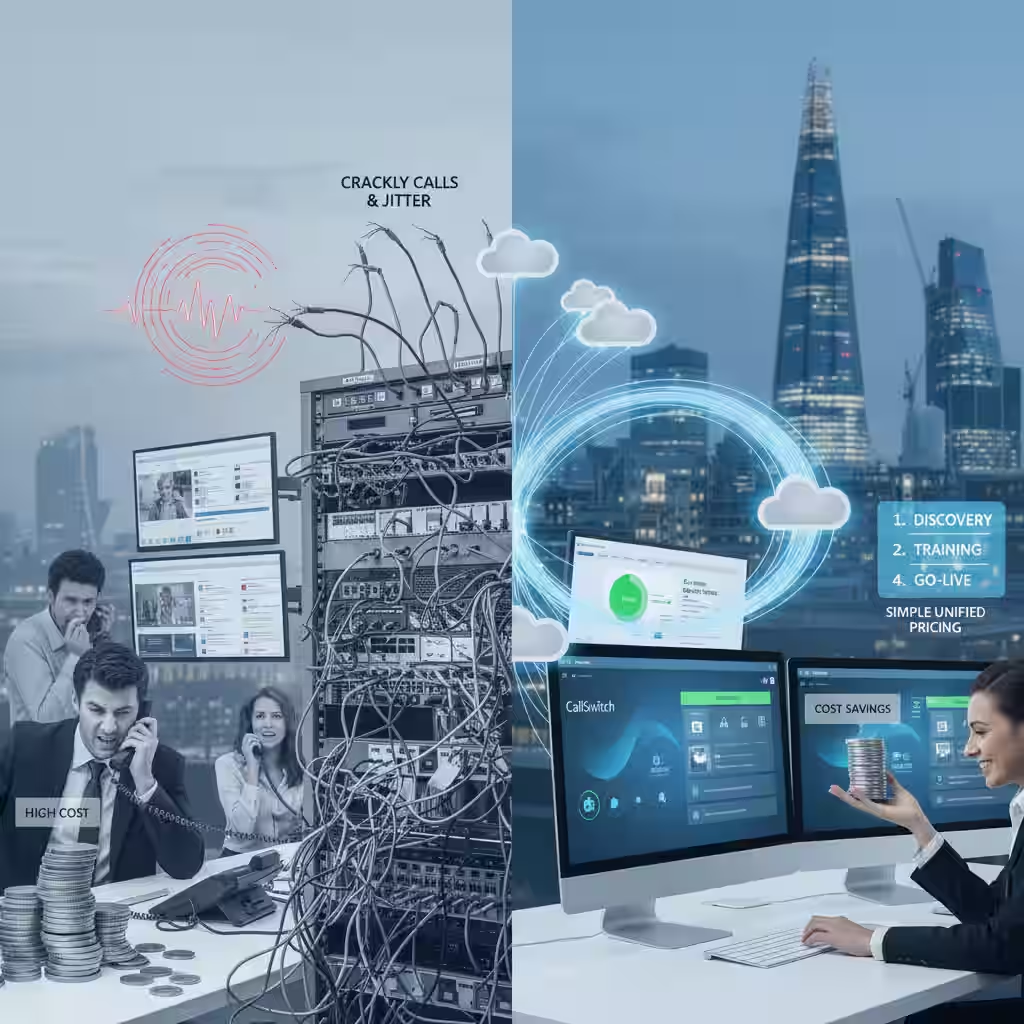Remote Worker Cybersecurity UK: Zero Trust, VPN, and Protecting Home Office Data
UK businesses face new cybersecurity challenges from remote and hybrid work. A practical three-layer defence strategy for distributed workforces and home offices.

Remote Work Cybersecurity Landscape: Why Home Office Is Under Pressure
The shift to remote and hybrid work has fundamentally changed the cybersecurity landscape for UK businesses. Employees now work from home networks, coffee shops, airport lounges, and client sites using personal devices or company laptops over uncontrolled internet connections. This distributed attack surface—spanning multiple networks, devices, and locations—creates security challenges that traditional perimeter-based defences cannot address.
Unlike office-based workers protected by corporate firewalls, network segmentation, and monitored systems, remote workers operate on the edge of corporate networks. Their devices connect directly to the internet, their home networks lack enterprise-grade security, and their work devices often blend with personal devices and file storage. A compromised home network, an infected personal laptop, or an unsecured WiFi connection can provide attackers with a direct pathway into company systems.
Remote workers are also targeted specifically because attackers know work-from-home setups prioritise accessibility over security. VPN connections are often optional, multi-factor authentication (MFA) is frequently bypassed for convenience, and security training is rarely tailored to home office risks. Recent studies show that 43% of UK remote workers have experienced a security incident while working from home, and 67% admit they don't follow company security policies consistently.
Small to medium businesses (SMBs) face the greatest risk. They often lack dedicated IT security staff, provide minimal remote work security guidance, assume employees will "be responsible," and don't monitor remote access activity. Large enterprises have invested in zero-trust architectures and remote security frameworks; SMBs often haven't.
The Real Threats: What's Actually Targeting Remote Workers
Remote workers face a unique threat landscape. Attackers know that home networks are less defended than corporate networks, that employees working remotely often have fewer eyes on them, and that work-from-home setups create social engineering opportunities.
Phishing and social engineering remain the primary attack vectors for remote workers. Attackers impersonate IT support, HR teams, or management to trick employees into revealing credentials or downloading malware. A remote worker alone at their desk, without colleagues or IT staff nearby, is more vulnerable to convincing social engineering. Recent data shows that 72% of remote worker breaches began with a phishing email or phone call.
Once inside, attackers exploit weak access controls. They leverage compromised credentials to access company email, cloud storage, and business applications. They move laterally toward higher-value targets: financial systems, customer databases, or intellectual property. A compromised home worker with standard company access can become a launching point for broader attacks on company infrastructure.
Secondary threats include: unsecured home networks providing WiFi interception, personal devices accessing company data without protection, unpatched software on home computers, and lack of device monitoring or incident response capability. Home workers also face personal security risks: package theft targeting deliveries, physical eavesdropping during video calls, and home network compromise affecting both personal and work data.
Understanding Remote Work Compliance: The Framework
Remote work cybersecurity compliance rests on three pillars: device security, access control, and network security.
Device Security: Endpoint Protection and Management
Companies must ensure remote worker devices—whether company-owned or personal—are secured to corporate standards. This requires endpoint protection (anti-malware, behavioural analysis), endpoint detection and response (EDR) for threat hunting, and mobile device management (MDM) for policy enforcement. Devices should enforce encryption, password policies, automatic updates, and disallow personal app installation. Companies that allow bring-your-own-device (BYOD) without security controls create significant risk.
Access Control: Zero Trust and Conditional Access
Remote work requires zero-trust architecture: assume every access request could be compromised and verify every connection. This means multi-factor authentication (MFA) is mandatory for all remote access, conditional access policies require additional verification for unusual access patterns (new location, new device, unusual time), and privileged access management (PAM) restricts administrative access. Traditional VPN-based access—which grants broad network access once connected—is considered inadequate for modern remote work.
Network and Data Security: Encryption and Monitoring
All remote access must be encrypted end-to-end. Company data in transit and at rest must be encrypted. Cloud applications should require authentication within the app, not just network-level VPN access. Companies should implement data loss prevention (DLP) tools that prevent downloads of sensitive information to personal devices or cloud storage. Network traffic from remote workers should be monitored for unusual access patterns or data exfiltration.
What Regulators and Compliance Frameworks Expect
Question 1: How are you securing remote worker devices?
Regulators expect evidence of endpoint protection, EDR or equivalent detection capability, encryption of data at rest, automatic updates, and policy enforcement. They also expect companies to verify device compliance before allowing access: does the device have password protection? Is it encrypted? Is antivirus active? Can you revoke access if compliance is lost?
Question 2: How are you controlling remote access?
Regulators expect MFA on all remote access, conditional access policies requiring additional verification for unusual patterns, and audit logs showing who accessed what and when. They expect companies to have tested access revocation: can you demonstrate that a departed employee's remote access was disabled immediately?
Question 3: How are you preventing data exfiltration from home networks?
Regulators expect data loss prevention (DLP) tools preventing downloads of sensitive information, encryption preventing interception over home networks, and monitoring of unusual data flows. They also expect companies to test: can you identify if a remote worker downloads a large volume of customer records or financial data?
Question 4: How are remote workers trained on security?
Regulators expect evidence that remote workers receive security training covering home office risks, phishing recognition, password hygiene, and data handling. They expect companies to have conducted phishing simulations targeting remote workers. They also expect documented remediation: if remote workers fail simulations at higher rates than office workers, what re-training did they receive?
The Three-Layer Defence Framework for Remote Work
Layer 1: Prevention
This layer stops most attacks before they compromise remote workers. Layer 1 includes endpoint protection (anti-malware, anti-ransomware) on all remote worker devices, email security filtering phishing, mandatory MFA on all access, and employee security awareness training. Prevention is the highest-ROI investment.
For remote workers specifically: deploy endpoint protection with EDR capability on all devices. Enforce MFA on all access to company systems and cloud applications. Use conditional access policies requiring additional verification for unusual patterns (new location, new device, unusual time). Provide security training covering home office risks, phishing tactics, password hygiene, and data handling. Enable users to report suspicious emails and calls easily.
Layer 2: Detection
Even with strong prevention, some attacks will get through. Layer 2 ensures you detect compromises quickly. This includes endpoint detection and response (EDR) monitoring remote worker devices, user and entity behavior analytics (UEBA) detecting unusual access patterns, and network monitoring identifying data exfiltration attempts. Detection is about monitoring the right signals and responding quickly.
For remote workers specifically: monitor EDR alerts for malware, unusual process execution, or credential access on remote devices. Use UEBA to detect unusual login patterns (impossible travel—login from two countries too quickly), batch data downloads, or access outside working hours. Monitor for data exfiltration: USB drives, cloud storage uploads, or email forwarding. Alert should trigger investigation within one hour.
Layer 3: Response and Recovery
When prevention and detection fail (and they will), Layer 3 minimizes damage. This includes incident response playbooks tailored to remote work incidents, forensic capabilities to investigate compromised devices, rapid access revocation, and secure device rebuild procedures. Layer 3 also covers communication with affected remote workers and regulatory notification if required.
Companies should establish rapid response capability for remote work incidents: can you disable a compromised remote worker's access within 15 minutes? Can you forensically image their device? Can you communicate remediation steps clearly to the employee?
Implementation Roadmap: Remote Work to Security Compliance
Month 1-2: Assessment and Policy
Conduct an audit of remote worker security: what devices are accessing company systems? Which don't have endpoint protection? Which lack encryption? Which workers have never completed security training? Develop remote work security policies covering device requirements, access controls, data handling, and incident response. Assign accountability for remote work security governance.
Month 3-4: Device Security and Access Control
Deploy endpoint protection on all remote worker devices. Implement MDM/MAM for policy enforcement and device compliance monitoring. Enforce MFA on all remote access and cloud applications. Implement conditional access policies requiring additional verification for unusual patterns. Roll out security training covering home office risks, phishing, and company policies. Run phishing simulations targeting remote workers.
Month 5-6: Detection and Monitoring
Deploy EDR (Endpoint Detection and Response) on all remote devices for threat hunting. Implement UEBA (User and Entity Behavior Analytics) to detect unusual access patterns. Enable data loss prevention (DLP) to prevent sensitive data downloads. Set up monitoring for data exfiltration attempts. Establish alert procedures and test incident response: can your team revoke access and investigate within one hour?
Month 7+: Operationalization
Run quarterly security awareness training for remote workers. Conduct monthly phishing simulations with documented results. Review EDR and UEBA alerts weekly for patterns. Conduct quarterly incident response drills. Document all controls for compliance audits. Brief leadership monthly on remote work security metrics.
Common Remote Work Security Failures
Failure 1: No Endpoint Protection
Companies assume employees are "working from home safely" but have not deployed endpoint protection, EDR, or device monitoring. When ransomware hits a remote worker's device, the company can't detect it, can't investigate it, and doesn't know the scope of compromise.
Failure 2: MFA Optional, Not Mandatory
Remote workers are offered MFA but it's not required. Employees complain about friction and disable it or use weak second factors (SMS). When phishing succeeds, attackers gain full access to company systems. Regulators view optional MFA as inadequate.
Failure 3: VPN Access Too Broad
Companies provide VPN access that grants broad network access to all company systems. Compromised remote worker VPN credentials allow attackers to move laterally and access sensitive systems. Modern approach: zero trust with conditional access and narrow application-level permissions, not network-level VPN access.
Failure 4: No Data Loss Prevention
Companies don't monitor or prevent sensitive data downloads from remote worker devices. Compromised remote workers download customer databases, financial records, or intellectual property to personal cloud storage and exfiltrate it. Regulators view this as preventable breach.
Failure 5: Inconsistent Security Training
Remote workers receive generic security training but not remote-work-specific training. They don't understand home office risks, don't recognize remote work phishing tactics, and don't follow company policies consistently. Phishing simulations show remote workers fail at 2-3x higher rates than office workers.
Board and Leadership Accountability
Remote work security is now a board-level issue. Companies are facing regulatory fines for remote work breaches, lawsuits for inadequate remote security frameworks, and reputational damage when home-office data breaches become public.
Leadership should be reporting on: (1) percentage of remote workers with endpoint protection and EDR deployed, (2) MFA adoption and enforcement, (3) phishing simulation failure rates for remote workers vs office workers, (4) number of remote work security incidents and outcomes, and (5) data loss prevention test results (what data was prevented from exfiltration?).
Companies should also conduct security assessments of their remote work infrastructure. External validation identifies gaps before incidents happen.
The Path Forward
Remote work security is achievable. Companies can move from ad-hoc remote work to comprehensive remote security frameworks in 6-9 months by implementing endpoint protection, enforcing MFA, deploying EDR/UEBA monitoring, and providing targeted security training.
The alternative—assuming remote workers will "be responsible"—is costly. Average remote work breach costs £200,000-£500,000 in incident response, downtime, regulatory fines, and reputational damage. Remote work security investment, by contrast, costs £30,000-£60,000 per year depending on workforce size.
Distributed workforces are here to stay. Your business should be asking: Do we have the security framework to protect remote workers and company data?
Stop Threats Before They Disrupt — Secure Your Business Now
Stay Ahead: Leading Cybersecurity Threat Intelligence, Direct to Your Inbox
Monthly expert-curated updates empower you to protect your business with actionable cybersecurity insights, the latest threat data, and proven defences—trusted by UK IT leaders for reliability and clarity.



